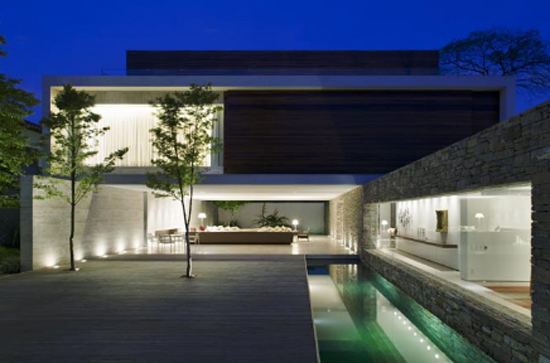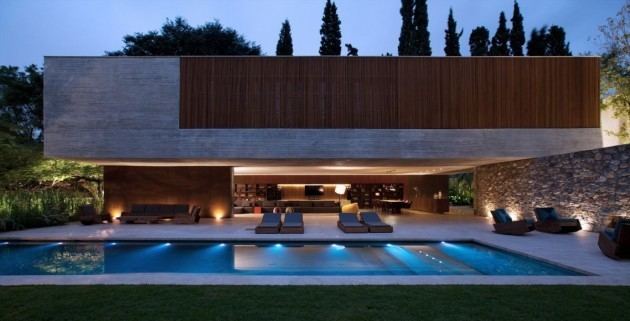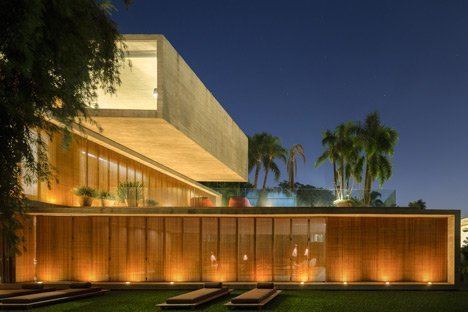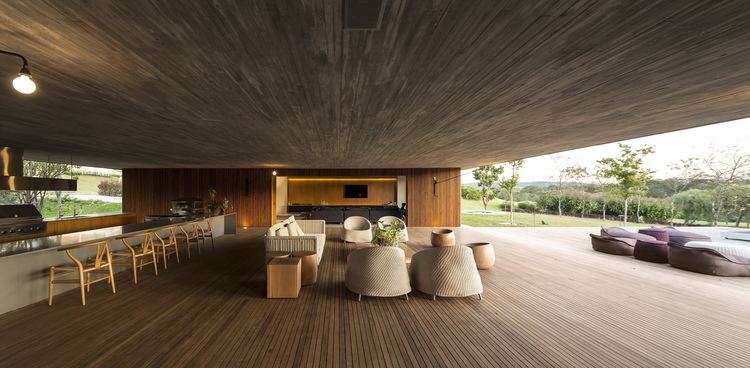Movies Went With The Wind Role Film director | Name Marcio Kogan Occupation Architect | |
 | ||
Alma mater | ||
Marcio Kogan retrata os 40 anos do studio mk27 com desenhos | Arquitetura
Marcio Kogan (born March 6, 1952, São Paulo, Brazil) graduated from the School of Architecture and Urbanism at the University Presbyterian Mackenzie in 1976. He is the son of Aron Kogan, an engineer, who became known in the 50’s and 60’s for the design and construction of large buildings in São Paulo, such as Edificio São Vito and Edificio Mirante do Vale. During the onset of his carecer, Marcio divided his time between cinema and architecture, in partnership with Isay Weinfeld, his friend from university. In 1988, the duo produced a feature-film called “Fire and Passion”, and, between 1995 and 2004, they did 5 expositions together about architecture and humor.
Contents
- Marcio Kogan retrata os 40 anos do studio mk27 com desenhos Arquitetura
- Caledonian marcio kogan viviendas exclusivas
- First projects
- The 90s
- The decade of 2000
- The decade of 2010
- Studio MK27
- Principal architecture projects
- Principal design projects
- Exhibits
- References

In 2001, Marcio Kogan’s Office changed its name to Studio MK27 and since then has gained greater international projection. Currently, besides what he is working on in Brazil, he also has projects in countries such as Peru, Uruguay, Chile, United States, Canada, Spain, Portugal, Switzerland, India, Israel and Indonesia. In 2011, Kogan was selected to be an Honorary Member of the American Institute of Architecture (AIA), for the entirety of his work, in a ceremony realized in New Orleans. In 2012, Studio MK27 represented Brazil in the Venice Biennale of Architecture, in the exposition at the national pavilion curated by Lauro Cavalcanti, who also had an outstanding Lúcio Costa installation.

Kogan’s projects are characterized by their architectural detail, formal simplicity, strong relations between the internal and external, great climactic comfort through passive sustainability, use of pure volumes and the application of traditional elements such as mashrabiyas and by designing a functional internal plan. Furthermore, he favors the use of raw materials such as wood, concrete and stone. In his projects there is almost always a reference to Brazilian modern architecture, of which Marcio has already declared himself a great fan. The New York Times critic Paul Goldberger cited Kogan in 2013 as one of the principal references of Brazilian Contemporary Architecture.

Caledonian marcio kogan viviendas exclusivas
First projects

During the first years of his career, the architectural projects were divided with Kogan’s dedication to film-making. Between 1973 and 1979 he produced – together with Isay Weinfeld – 13 short films in Super 8, winning numerous awards in national festivals. In 1983, the two made another short film, now in 35mm, “Idos com o Vento”, which received a prize at the Gramado Festival and at the Ibero-American Cine Huelva in Spain. Five years later, they launched their first and only long-feature, Fire and Passion (1988), with a star-filled cast that included Mira Haar, Cristina Mutarelli, Carlos Moreno, Rita Lee and Fernanda Montenegro. All of their film productions had a strong relation with humor, above all though visual jokes, expressed by the interaction of the characters and the scenario.
In Architecture, the principal projects of the onset of his career were the buildings of his office in 1977 (located in São Paulo) – where he still maintains his activities – and Edificio ljis (a 12-floor Residential building), finished in 1980. Other than there solo projects, he also did with Weinfeld the Goldfarb House in 1989, which brought references of Vila Arpel From the film My Uncle by Jacques Tati.
The 90’s
During the decade of the 90’s, Kogan and Weinfeld designed the Metropolis Building (a residential torwer in Morumbi), finished in 1996, and the Hotel Fasano, one of the most important luxury hotels in São Paulo, and headed by a traditional family of restaurateurs of the city. Construction of Fasano started in 1996 and was completed in 2003. The partnership in film-making opened for exhibits about architecture and humor.
Among the individual architectural projects developed in the 90’s, the outstanding ones are the Larmod Store and the Uma Store in Vila Madalena. The projects explored the internal spatiality with large ceiling-heights and minimized the use of materials and colors, almost always done in white mortar.
The decade of 2000
In 2001, Marcio Kogan’s office became more collaborative and also received a new name, Studio MK27. The work system adopted gave greater freedom as well as responsibility to the architects, who have also now become co-authors of the projects, signing together with Kogan. In this organization, the task division was minimized and each architect accompanied all of the phases of the project, from the briefing with the client until the project delivery.
Already in this phase, the Gama Issa House (2002) was greatly published in international magazines. Highlights from these first years of Studio MK27 also include Coser Photographic Studio – built within an industrial warehouse in the Cambuci neighborhood of São Paulo – and the Microbiology Museum at the Butantan Institute in São Paulo – a retrofit of an older structure, transformed into a center for didactic activities.
During the first decade of the 20th century, two of Studio MK27 houses won the Record House Award, promoted by the prestigious North-American magazine Architectural Record: the Du Plessis Home (2004), which does a re-reading of the traditional elements of Brazilian architecture, such as veranda, the mashrabiyas and the patio, and shortly thereafter BR House (2005). For Micasa VolB, Studio MK27 returns with humor in architecture, this time in a commentary in Brazilian modernism. The project of this furniture store-showroom was largely defined in discussion on the work-site. The traditional exposed concrete was done randomly, and building elements such as steel reinforcing bars were used as brises-soleil.
Paraty House, concluded in 2009, received great attention from the specialized media, winning 10 international awards, including the Wallpaper* Design Award promoted to by the British magazine.
The decade of 2010
This period is marked by the internationalization of Kogan’s production and the diversification of the architectural programs. The ongoing projects include hotels in Portugal and Indonesia, and projects being concluded in Chile and Uruguay.
In 2011, Kogan was selected to be an Honorary Member of the American Institute of Architects (AIA), also given to another Brazilian, Angelo Bucci, that same year. For the Venice Biennale of Architecture in 2012, Studio MK27 produced a video installation representing fictional in the V4 House. The Brazilian Pavilion was greatly praised by the international media including the British paper “The Guardian” with the critic Steve Rose classifying the installation as the “highlight of the Biennale” and “great fun”.
Furthermore, Studio MK27, during these last few years, began designing furniture, including fixtures, taps and a bathtub. Among the main international awards received recently, highlights include: Leaf Awards with the Punta Casa (2011) and the M&M House (2013), the Record House with Bahia House (2011) and the World Architecture Festival (WAF) with the Decameron Store (2011), Record Interiors with Studio SC (2012) and the International Design Award with the Redux House (2014). Studio R was selected in 2014 as a finalist in the Mies Crown Hall Americas Prize as one of the 36 projects built in America between 2000 and 2013.
In 2014, Moleskine launched a supplement about Studio MK27 showing the quotidian in the office, sketches and their main inspirations. The book will be a part of the series “Inspiration and Process in Architecture”.
Studio MK27
The office is comprised, besides Marcio Kogan, by Beatriz Meyer, Carlos Costa, Carolina Castroviejo, Constanza Cortes, Diana Radomysler, Eduardo Chalabi, Eduardo Glycerio, Elisa Friedman, Eline Ostyn, Gabriel Kogan, Giovanni Meirelles, Lair Reis, Laura Guedes, Luciana Antunes, Márcio Tanaka, Maria Cristina Motta, Marianna Ruzante, Mariana Simas, Oswaldo Pessano, Pedro Ribeiro, Renata Furlanetto, Samanta Cafardo and Suzana Glokowski.
Since 2001 Studio MK27 has won more than 200 Brazilian and international awards, as IAB-BR, WAF, Architectural Review, Dédalo Minosse, Record House, LEAF, D&AD, Sparks, Barbara Capochin, Icônico, AZ and Wallpaper Design Award.
